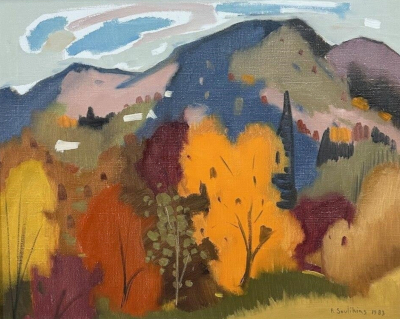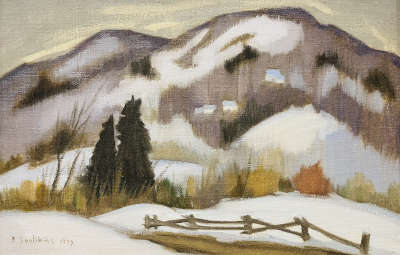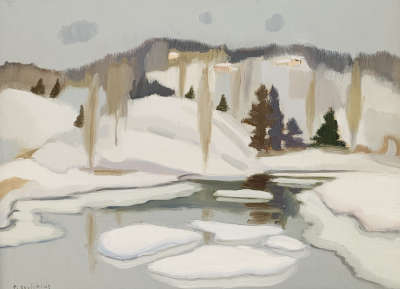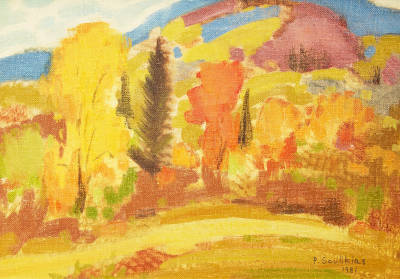sold artworks
Paul Soulikias, I.A.F.
Canadian
Born: Komotini, Greece 1926-10-13
Died: Larissa, Greece 2023-01-17
Selected works
Biography
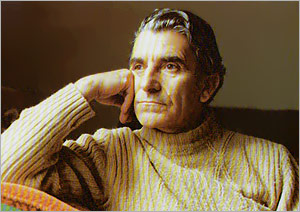
Colour, composition, the inner character and poetry of the subject for the artistic rendering of Canadian nature and all natures: These are the characteristics of Paul Soulikias`s art observed by Canadian and Greek art critics as well as fellow artist painters since 1965. With a harmonization between artistic form and subject content, P. Soulikias communicates the beauty of art with an optimism which most of the time is expressed in celebrating nature and life. “However when the subject demands it, he can be sombre and critical” .
Paul (Paleologos) Soulikias was born in Komotini, Thrace, Greece in 1926 but grew up in Volos, Thessaly. His father was from Fanari, a small Thessalian town, and his mother, a refugee from Eastern Thrace. As a child, teenager and young man, he lived through the horror of the German Occupation and its troubled aftermath in Greece.
The times fell short in satisfying young Paul`s innate capabilities which consisted of a keen visual perception, a strong mathematical intelligence and a vivid imagination. No education was accessible to cultivate his raw artistic talent.
In the end, it was these very capabilities that gave him the strength to overcome the insurmountable obstacles of his life and study art. As soon as the Germans left Greece, he found employment and began to study drawing and painting. First, on his own, he managed to depict the likeness of his subjects, such as landscapes and portraits. Yet he knew very well the great demands of art. He had great respect for art and wished to be honest with it and with himself. Consequently, he went to Athens and worked his way through the ABC School of Art and continued to expand his knowledge. Thus he was ready to enter “the most difficult of all schools, that of Nature” as he often calls it. Working at this school, he mastered the knowledge of painting all subjects while handling them creatively. He read literature, loved music and all arts.
In 1956, he went to Paris where he intensively studied the great masters of the Louvre. He painted scenes along the river Seine. He met and observed many artists at work next to him.
He returned to Greece and in 1959 he left for Canada with a broad knowledge of painting. This knowledge combined with his strong intellectual capabilities and his creative talent enabled him to “conquer” the magnificent Canadian nature and to render it artistically with a “fresh look”.
Montrealers began to know his work in 1965 when he participated in a Montreal-based art contest for the Neo-Canadians and received the first prize accompanied by a praising review by art critic Michael Ballantyne who wrote:
“The outstanding picture in the exhibition was P. Soulikias` landscape. It occupies pride of place according to the judges` decision. A richly textured canvas with a very assured and subtle handling of colour… One gets the feeling that the artist has absorbed the subject in his bones…” (The Montreal Star, January 30, 1965). As the artist himself says, “I do not paint what I see but what exists”. This prize entitled P. Soulikias to participate in the exhibition for the Quebec artists, again, organized by the City of Montreal in the same year. The same art critic found his painting “…absolutely delightful, beautifully constructed and bathed in some of the softest most exhilarating greens I have ever seen! Mr. Soulikias merits a Gallery XII at the Montreal Museum of Fine Arts show soon, and I hope he gets it” (The Montreal Star, July 10, 1965).
In the same year, P. Soulikias was honoured by the City of Montreal and invited by the mayor to sign the city`s Golden Book.
After this success, during his free time in the summer of 1965, P. Soulikias found himself in the Laurentians. There, he produced some of his most beautiful greens. In December of that year, he exhibited his works in Galerie de la Place. This time, Michael Ballantyne expressed his pleasant surprise for the artist`s original representation of the Laurentians. The title of his article was “A Fresh Look at the Laurentians”, meaning Soulikias`s personal style. Here is a small extract:
“Do I hear a groan in the background? Haven`t the Laurentians been painted right out of existence by now? Well, I might have thought so too, but for the fact that in these canvases a fresh eye is brought to bear and the familiar is rendered unfamiliar, the commonplace unusual… The harmonies in the best of these works are quite ravishing…” (The Montreal Star, December 4, 1965, Michael Ballantyne).
In 1966, P. Soulikias was married to the educator, Helen Kantza who in 1967 had been offered a position as a school teacher in a town of Western Quebec. It was then that he devoted all his time to his painting, studying and expressing artistically the Canadian autumn and winter.
In 1967, important Montreal galleries began to show his paintings. These were Gallery Moose and Galerie Gauvreau on Sherbrooke Street. In 1968, he began a long association with Galerie L`Art Français of Montreal with whom no two years went by without an exhibition. Many exhibitions followed in Montreal, Ottawa, Quebec City, Chicoutimi and Rockport Mass. and his work began to reach the Canadian public. During a solo exhibition at the Galerie L`Art Français in 1971, the art critic Helene Ouelet wrote: “…with a very thin layer of colour, Paul Soulikias creates compact masses in which the overall impression is more important than the detail; trees, hills and clouds are treated as a whole, and rendered perfectly by a sure sense of colour composition… In a winter landscape entitled “Oka”, grey tones and mauve shadows accentuate the atmosphere of glacial cold, while in the landscape “Shawbridge”, warm tones with the luminous ones render well the North American autumn. Besides his landscapes, P. Soulikias shows some still lifes, portraits and compositions with people. However, his main theme is the Canadian landscape. And by his grasp of landscape, this European artist is renewing the rich tradition of the Group of Seven and of all those Canadian artists who have made nature their guide and inspiration” (Vie des Arts Magazine, Summer 1971, no.63).
In 1974, P. Soulikias had a one-man show in Athens, Greece. His fellow artists there expressed their admiration for his works. The art critics admired them as well. Here are small extracts from only two of them: “…Paul Soulikias was able not only to overcome the difficulties caused by the different experience of the Canadian nature, but on the contrary, he renders this nature with plastic liberty. He has conquered it… What impressed us greatly is his artistic ability which in some cases reaches the decorative invention and in others, the plastic sensitivity of the snow. With an excellent knowledge of colour and composition, he has not stopped in the inventions of a primitive who imitates the child in spite of his learning. Paul Soulikias`s paintings are well organized compositions which easily guide our feelings to a pleasant elevation with an expectation of the simple and strange…” (Diane Antonakatou, Imerisia, March 22, 1974). “P. Soulikias is not interested in the details but in the harmony of colour. He sees colour as form. He simplifies, subtracts, and adds within the measure of reason. He plays creatively with the colour, and the result is a dreamy colourful harmony which surprises us while at the same time gives us serenity. His paintings are between truth and dream. They are poetry. He is daring with colour and innovative. All those qualities elevate him to a prominent place in the field of visual arts of Canada and Greece.” (Zisis Aferim, Smyrna, April 1974).
In the summer of 1976, he made a tour of the North Atlantic coast, from Rockport, Massachusetts to Maine and Nova Scotia, ending up in Gaspé`s Metapedia Valley. He painted boats in small ports, and fishing villages. In the same year, he had a successful exhibition of water colours in Galerie Robert Rouiller.
In March 1978, he exhibited in Quebec City. Guests of honour were the ambassador of Greece and the mayor of Quebec City. A councillor of the City presented P. Soulikias with an official coat-of-arms jacket pin and told him: “Mr Soulikias you have rendered the character and soul of our landscape and villages in your paintings and done it artistically”. P. Soulikias began to show his paintings in important galleries since 1965. But his association in 1974 with The Dominion Gallery, one of the most prestigious in North America, was crucial for his artistic career. Dr. Max Stern, the owner of the gallery who showcased in his gallery only a few great Canadian artists and big names from all over the world, began to purchase and display Soulikias`s paintings. He believed that: “P. Soulikias is an artist painter of international stature…” (Secrets des Artistes, January 11, 1975 and CBC TV, November 25, 1982).
In 1982, Dr. Stern offered P. Soulikias an exhibition together with the sculptor Henry Moore. It was a special exhibition for the presentation of a book about P. Soulikias`s work published in the Signature series. The Mexican compositions of people in this exhibition were a new development of the artist. Once again, P. Soulikias showed his ability to adapt himself easily to any physical and cultural environment and convey the inner character of his subject whatever it may be. P. Soulikias`s paintings reached all corners of Canada and several cities abroad. From 1983 to 1985 he held exhibitions in Montreal, Toronto, Edmonton, Vancouver, New York and Athens.
In 1985, during a second exhibition in Greece at the Kreonidis Gallery, Beatriki Spiliadi compared his paintings to: “… the discreet music of a sourdine, a musical instrument which subjects us to the emotions of the artist…” and that “in his colours we find his personal contribution to the visual arts” (Eleftherotypia, February 26, 1985).
Ten years later, in 1995, The National Bank of Greece with the initiative and support of its Governor G. Mirkos organized two more exhibitions in Greece. The first one at the Melas Mansion in Athens and the second one at the bank`s cultural centre in Thessaloniki. Regarding the exhibition in Athens, the art historian Dora Iliopoulou-Rogan wrote: “…away from academicisms, “currents” and stock market practices in art, P. Soulikias expresses himself in such a way as to always remain faithful to himself. Turning a deaf ear to the sirens of the recurring trends, he tries something very rare in our days: to create with a commendable modesty, works which decipher his sensitivity, while at the same time, strike our own inner chords. This double communication ensures and guarantees the purity of his paintings, away from the deceitful stimulants and other similar conditions, foreign to art” (The National Bank Magazine, June 1995, No. 5). During the opening of the exhibition in Thessaloniki, the Canadian ambassador Mr. Derek Fraser was the guest of honour. He spoke about P. Soulikias`s artistic career in Canada and of his contribution to Canadian art for over 35 years.
The continuous recognition of P. Soulikias resulted in the publication of a second book about the artist, sponsored by ABB and Thirau companies. This book contains around 70 paintings in colour and many sketches in black and white. It is a complete representation of P. Soulikias`s work. A special exhibition was held at the Montreal Museum of Fine Arts in November 1996 for the launching of his book.
P. Soulikias`s exhibition in Thessaloniki, the Cultural Capital of Europe 1997, organized by the Canadian Embassy in Greece, was an occasion for Canada and Greece to be partners in this great celebration of culture.
P. Soulikias has attended international art symposia in Quebec and has enjoyed the friendship of many Quebec, Canadian and several U.S. artists. On his part, he devoted his artistic work for over 35 years to Quebec and Canada, creating landscapes, portraits, still lifes and life compositions.
In 2004, he was honoured by the Olympic City of Nea Ionia with an exhibition for the celebration of the Olympic Games held in Greece in 2004. His latest exhibition in August 2005 was organized by the municipality of Sparta. It was a special exhibition for his wife who had left Sparta in 1956.
Regarding the exhibition (Oct. 2006) marking P. Soulikias`s 80th birthday, the art critic Robert Bernier wrote:
“P. Soulikias is an excellent artist painter… He does not only spread colour on his canvas. But he has possessed a manner to transform nature on his canvas… And after more than forty years of painting… P. Soulikias did not only last but has also contributed to the adventure of painting of the twentieth century in Quebec. …And continues.” (Parcours art & art de vivre magazine, Autumn 2006, Vol.12, no.3).
His paintings are shown in Montreal galleries and The Museum of Fine Arts. They are also in many public and private institutions such as the City of Montreal, Reader`s Digest, Telephone Quebec, Gazoduc TQM, ABB, The National Bank of Greece, Thirau and others, as well as in many private collections throughout Canada, the U.S.A. and Europe.
P.S. Paul and Helen Soulikias have two children: Klea-Penelope, a surgeon and Aristofanis, an architect. March 2007
Studied at
Collections
Exhibitions
1956 Tourist Office, Volos Greece
1963 Galerie La Mansard, Montreal
1965 Galerie de la Place, Montreal
1967 Eaton`s Gallery, Montreal
1969 Artists` Association, Chicoutimi
1970 University of Ottawa (with the cooperation of Wallack Gallery)
1971 Galerie L`art français, Montreal
1972 Artists` Association, Rockport, Massachusetts
1973 Galerie L`art français, Montreal
1974 M. Valtanos Cultural Gallery, Athens
1975 Galerie L`art français, Montreal
1975 Galerie d`art Montcalm, Quebec City
1977 Galerie L`art français, Montreal
1978 Galerie d`Artagnan, Quebec City
1978 Centre Culturel de Verdun
1979 Galerie L`art français, Montreal
1980 Galerie L`art français, Montreal
1982 Dominion Gallery, Montreal
1983 K.G. Heffel Gallery, Vancouver
1984 Kasspar Gallery, Toronto
1984 G.Press & T.O., New York
1984 Galerie d`art Clarance Gagnon, Montreal
1985 Galerie d`art Vincent, Ottawa
1985 Kreonidis Gallery, Athens
1987 Galerie d`art Rimouski (unveiling of P.Soulikias` painting featured on the front cover of the Quebec City Telephone Directory)
1992 Galerie d`arts contemporains, Montreal
1995 Melas Mansion of the National Bank of Greece, Athens
1996 Giorgio De Chirico Cultural Centre, Volos, Greece
1997 Museum of Fine Arts, Montreal
1997 Picture Gallery of the Polytechnic School of Thessalonica, Thessaloniki Cultural Capital of Europe
1997 Porphyrogeneion Foundation, Agria, Volos, Greece
1997 Centre of Contemporary Art, Larissa, Greece
2001 Margonis Art Gallery, Larissa, Greece
2001 Municipal Picture Gallery, Karditsa, Greece
2004 Metaxourgio, Nea Ionia (Olympic City for the 2004 Olympics, Volos, Greece
2005 Municipality of Sparta
2006 Galerie Lamoureux Ritzenhoff, Montreal
2007 Giorgio De Chirico Cultural Centre, Volos, Greece
2008 French Institute, Larissa
2009 Honourary exhibition by the Prefecture of Magnesia at the Cultural Centre of Nea Ionia, Volos, Greece
2016 Paul Soulikias Honorary and Retrospective Exhibition in Nea Ionia, Volos
